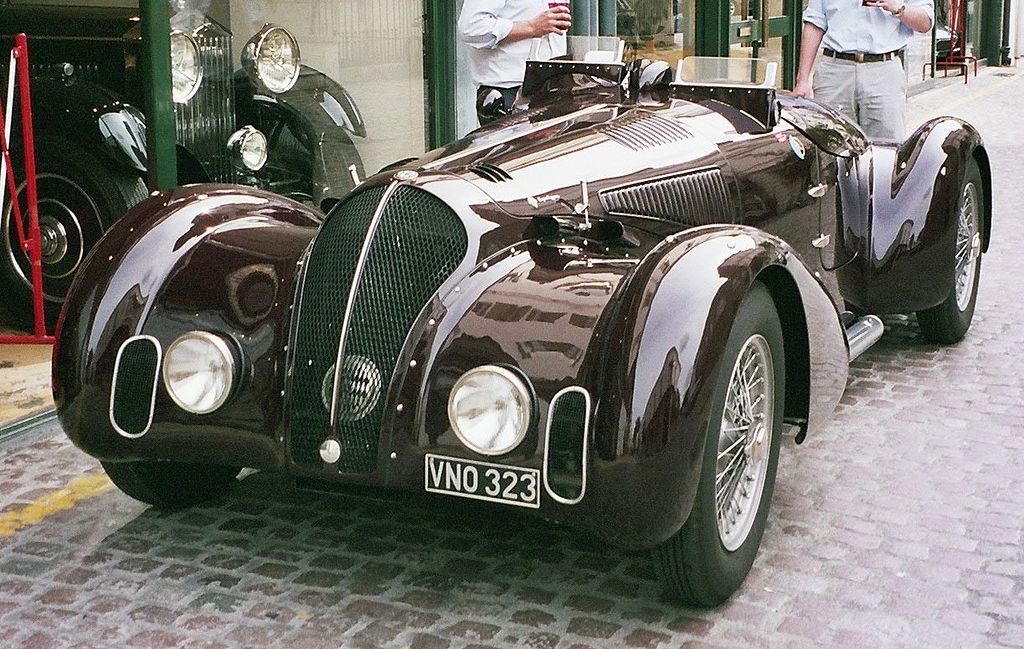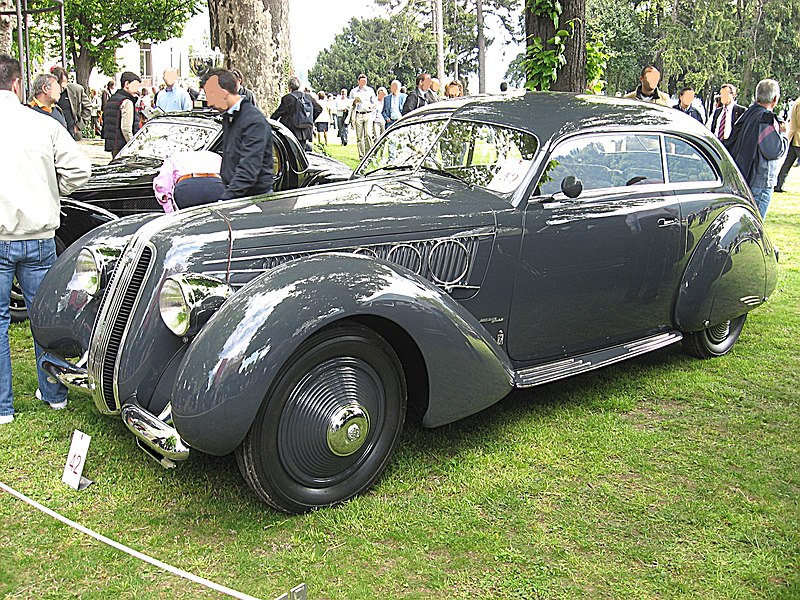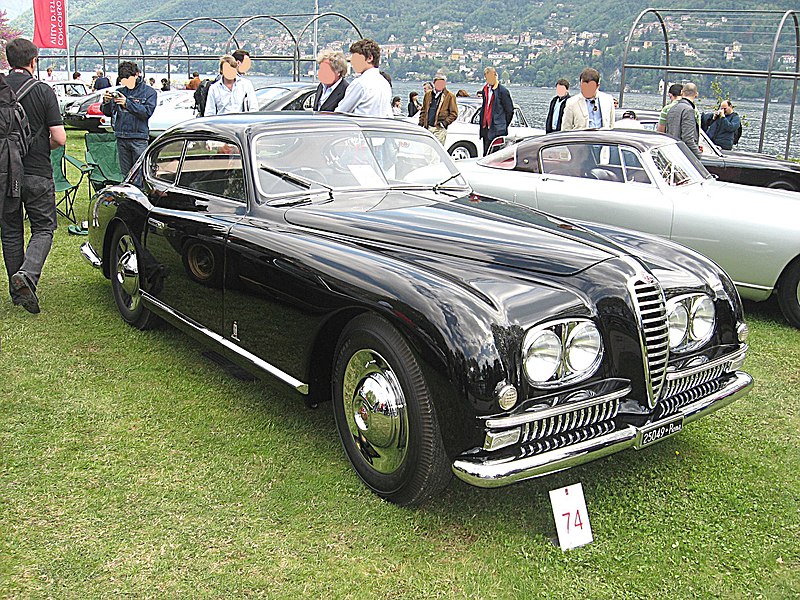1931-1934 8C 2300
The first model was the 1931 '8C 2300', a reference to the car's 2.3 L (2336 cc) engine, initially designed as a racing car, but actually produced in 188 units also for road use. While the racing version of the 8C 2300 Spider, driven by Tazio Nuvolari won the 1931 and 1932 Targa Florio race in Sicily, the 1931 Italian Grand Prix victory at Monza gave the "Monza" name to the twin seater GP car, a shortened version of the Spider. The Alfa Romeo factory often added the name of events won to the name of a car.
'8C 2300 tipo Le Mans' was the sport version of the '8C 2300' and it had a successful debut in the 1931 Eireann Cup driven by Henry Birkin. It won the 24 Hours of Le Mans in 1931 (Howe-Birkin); 1932 (Chinetti-Sommer); 1933 (Nuvolari-Sommer) and 1934 (Chinetti-Etancelin).
The 8C 2300 Le Mans model on display at the Museo Alfa Romeo was bought by Sir Henry Birkin in 1931 for competition use, but it is not the car in which Birkin and Howe won the 1931 Le Mans 24 hours.
A 1933 8C 2300 Le Mans, chassis #2311201, is part of the permanent collection at the Simeone Foundation Automotive Museum in Philadelphia, PA, US. The car was owned by Lord Howe who campaigned it in the 24 Hours of Le Mans in 1934 (DNF) as well as in 1935 when it set the fastest lap before retiring.
1933-1933 6C 1900
The Alfa Romeo 6C 1900 was the last derivative of the original 6C 1500, produced in 197 examples during 1933, as a transitional model before the new 6C 2300 was introduced the following year. Only made in Gran Turismo guise with a 2,920 mm (115.0 in) wheelbase, the 6C 1900 replaced the corresponding 6C 1750 model.Besides the larger displacement, other notable mechanical changes were aluminium cylinder heads, an improved frame and a new transmission. The same upgrades were applied to the 1933 model 6C 1750 Gran Sport, which together with the 6C 1900 forms the sixth series of the 6C. Alfa Romeo offered the 6C 1900 with an in-house 4-door saloon body; while bespoke coachbuilt body styles included 4-seat cabriolets.
The double overhead camshaft, naturally aspirated straight-six engine was bored from 66 mm (2.6 in) to 68 mm (2.7 in), bringing displacement to 1,917 cc (117.0 cu in). For the first time on a 6C the cylinder head was aluminium; some engines were also manufactured using an aluminium block with pressed-in steel sleeves in place of the usual cast iron block. With 68 bhp (51 kW) at 4,500 rpm the 6C 1900 could achieve a top speed of 130 km/h (81 mph). The improved frame consisted of fully boxed rails and crossmembers, instead of the 1750s C-shaped sections. A new four-speed gearbox was fitted, with synchromesh on the two top gears and a freewheel mechanism
1934-1937 6C 2300
The 6C 2300 (2309 cc) was designed by Vittorio Jano as a lower-cost alternative to the 8C. In 1934 Alfa Romeo had become a state-owned enterprise. This year was presented a new 6C model with a newly designed, larger engine. Chassis technology, however, had been taken from the predecessor. One year later, a revised model, called the 6C 2300 B was presented. In this version the engine was placed in a completely newly designed chassis, with individual front suspension and rear swing axle, and hydraulic brakes. The 6C-2300 was produced in 760 copies with rigid axles and 870 copies of the B-model.
1935-1939 8C 2900
The 8C 2900 was designed to compete in sports car races in general and the Mille Miglia in particular. It used the 2.9 L version of the 8C engine and was based on the 8C 35 Grand Prix racing chassis. As such, it had an inline 8-cylinder 2.9-litre engine using two Roots type superchargers fed by two updraught Weber carburettors and fully independent suspension with Dubonnet-type trailing arm suspension with coil springs and hydraulic dampers at front and swing axles with a transverse leaf spring at the rear.
The 8C 2900A was shown to the public at the 1935 London Motor Show and was advertised for sale there. The engine, with a compression ratio of 6.5:1 and a stated power output of 220 bhp (160 kW) at 5300 rpm, was detuned from the Grand Prix racing version. Ten 2900As were built, five in 1935 and five in 1936.
1939-1950 6C 2500
Introduced in 1938, the 2500 (2443 cc) was the last 6C road car. World War II was coming and car development was stopped, but a few hundred 6C 2500s were built from 1940 to 1945. Postwar, the first new Alfa model was the 1946 6C 2500 Freccia d'Oro (Golden Arrow), of which 680 were built through 1951, with bodies by Alfa. The 2500 had enlarged engine compared to the predecessor model, this Vittorio Jano designed double overhead cam engine was available either one or three Weber carburetors. The triple carburetor version was used in the top of line SS (Super Sport) version. The 2443 cc engine was mounted to a steel ladder frame chassis, which was offered with three wheelbase lengths: 3,250 mm (128.0 in) on the Turismo, 3,000 mm (118.1 in) on the Sport and 2,700 mm (106.3 in) on the Super Sport. Various coachbuilders made their own versions of the 2500, but most of the bodyworks was made by Touring of Milan.
The Tipo 256 was a racing version of 2500 made eight copies between 1939 and 1940 for Mille Miglia and the 24 Hours of Le Mans. It was made as Spider (convertible) and Berlinetta (coupe) Touring bodystyles. With power of 125 bhp (93 kW) it could achieve top speed of 200 kilometres per hour (120 mph).
It was sold to wealthy customers like King Farouk, Alì Khan, Rita Hayworth, Tyrone Power, and Prince Rainier. One was also featured in The Godfather in 1972.
The 2500 was one of the most expensive cars available at its own time. The last 6C was produced in 1952, and was replaced by the 1900.


.jpg/1024px-Alfa_Romeo_8C_2%2C3_l_Kompressor_(Foto_Spu_1975).jpg)











.jpg/800px-Alfa_Romeo_6C_2500_SS_-_MM_2014_-_(14055528997).jpg)











.jfif)


No comments:
Post a Comment